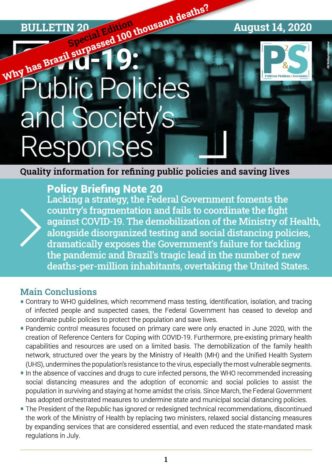Main Conclusions
- Contrary to WHO guidelines, which recommend mass testing, identification, isolation, and tracing of infected people and suspected cases, the Federal Government has ceased to develop and coordinate public policies to protect the population and save lives.
- Pandemic control measures focused on primary care were only enacted in June 2020, with the creation of Reference Centers for Coping with COVID-19. Furthermore, pre-existing primary health capabilities and resources are used on a limited basis. The demobilization of the family health network, structured over the years by the Ministry of Health (MH) and the Unified Health System (UHS), undermines the population’s resistance to the virus, especially the most vulnerable segments.
- In the absence of vaccines and drugs to cure infected persons, the WHO recommended increasing social distancing measures and the adoption of economic and social policies to assist the population in surviving and staying at home amidst the crisis. Since March, the Federal Government has adopted orchestrated measures to undermine state and municipal social distancing policies.
- The President of the Republic has ignored or redesigned technical recommendations, discontinued the work of the Ministry of Health by replacing two ministers, relaxed social distancing measures by expanding services that are considered essential, and even reduced the state-mandated mask regulations in July.
- By equating health performance with economic performance, the Federal Government caused the country to confuse its priorities. It ignored evidence suggesting that economic losses would be smaller insofar as the virus is contained. In health, the measures employed by the Federal Government were targeted primarily at increasing highly specialized care capacities, such as increasing ICU beds. Federal spending on economic and social assistance was practically three times higher than in health.
- As a result, the country is now at high risk. Brazil registers 468 total deaths per million inhabitants (total accumulated up to August 8) surpassed only by the USA, with 487 deaths per million inhabitants.
- However, when we look at the number of new deaths per million inhabitants, Brazil emerges in first place with 33 new deaths, ahead of the USA, which registered 24 new deaths between 08/02 and 08/08.
Work group responsible
Coordination: Tatiane C Moraes de Sousa (FioCruz) e Lorena Barberia (USP)
Researchers:
- Luiz Guilherme Roth Cantarelli (USP)
- Maria Letícia Claro de F. Oliveira (USP, CEPESP/FGV)
- Natália de Paula Moreira (DCP-USP)
- Isabel Seelaender Costa Rosa (USP)
- Pedro H. de Santana Schmalz (USP e CEPESP/FGV)
- Marcela Mello Zamudio (USP e CEPESP/FGV)
- Thiago Moraes (UNESP)
- Michelle Fernández (UnB)
- Paulo Flores (USP)
- Hellen Guicheney (USP, CEM, CEBRAP)
- Ian Prates (CEBRAP, Social Accountability International)
- Rogério Barbosa (CEM)
- Carolina Requena (USP, CEM)
- Anna Paula Ferrari Matos (USP)
- Ingrid Castro Loureiro Silva (USP)
- Dara Aparecida Vilela Pinto (USP)
- Paulo Agabo (USP)
- Carolina Langbeck Osse (USP)
- Raquel Requena Rachid (USP)
- Thiago Moraes (UNESP)
- Sérgio Simoni Jr. (UFRGS)
- Eduardo Lazzari (CEM, USP)
- Heloísa Fimiani (USP)
- Vitor Menezes (USP, Cebrap)
- Thiago Meireles (USP)
- João Lucas Sacchi (USP)


